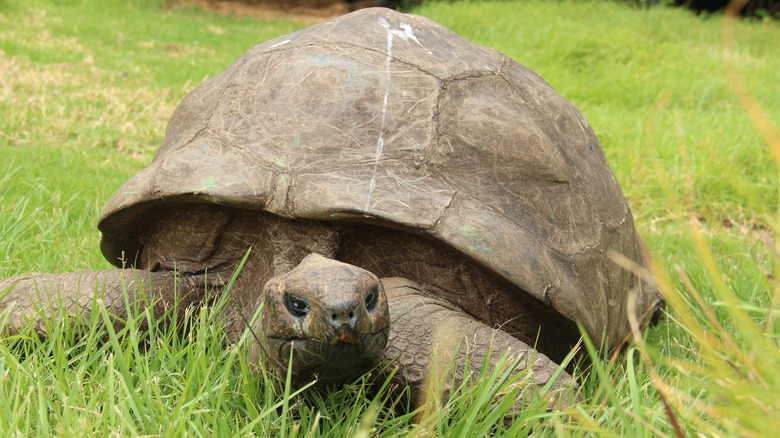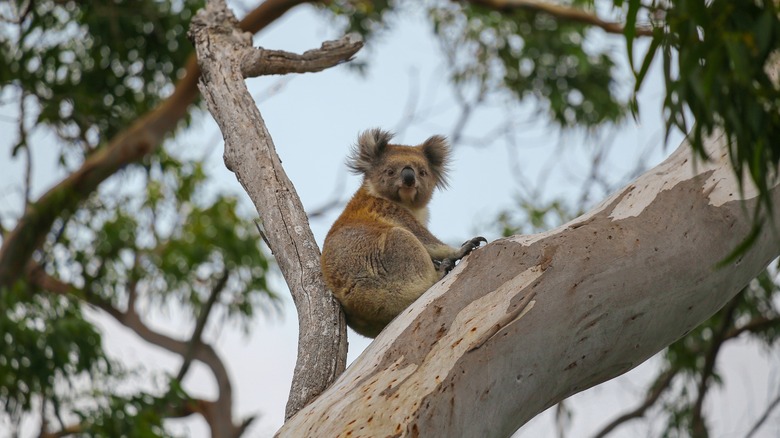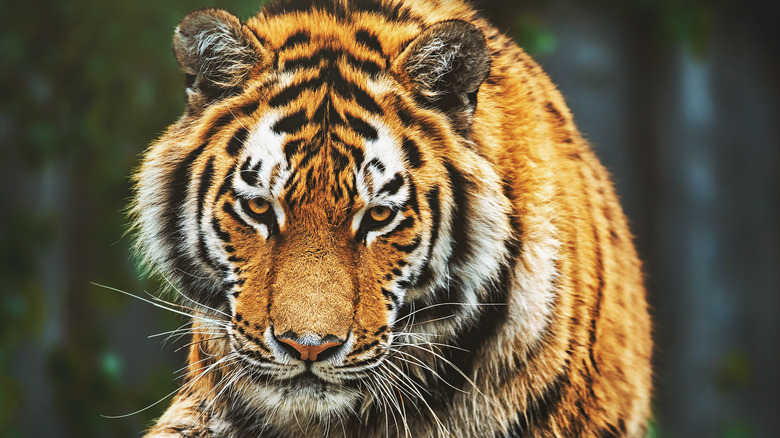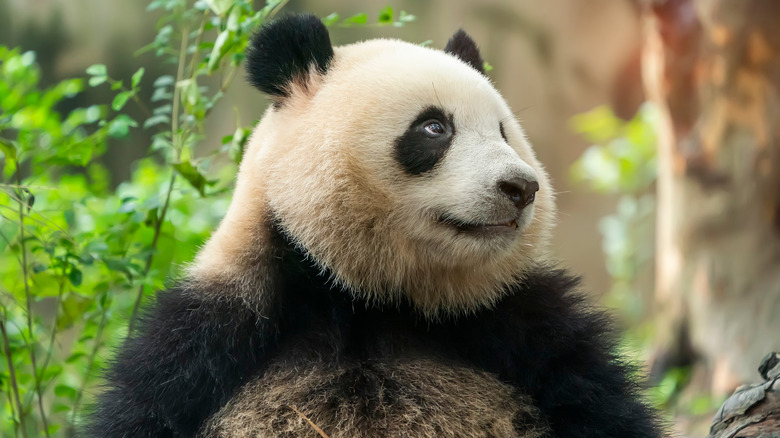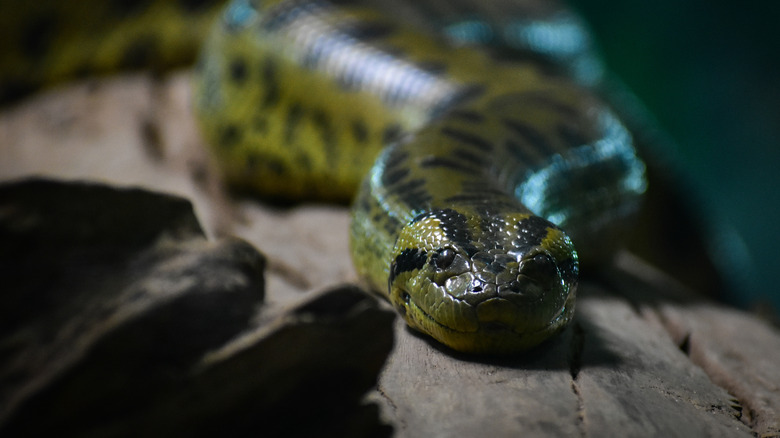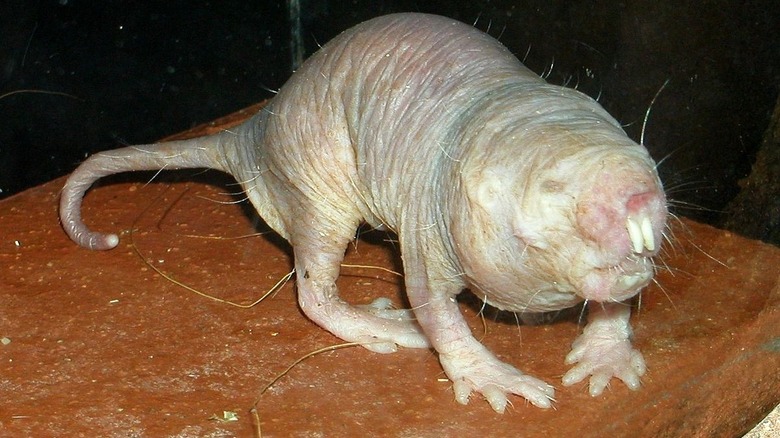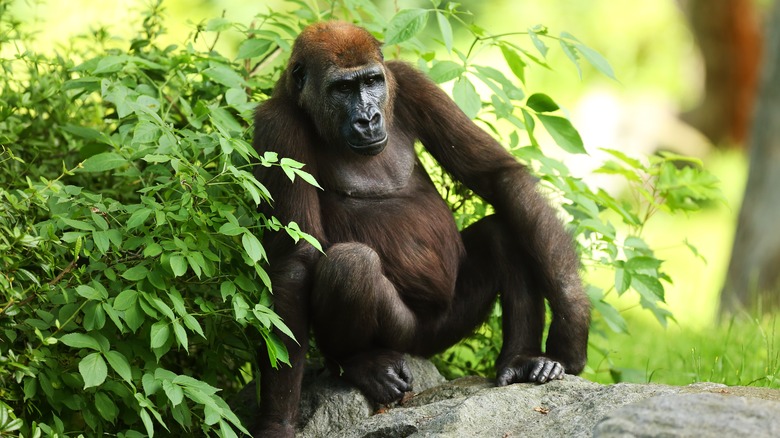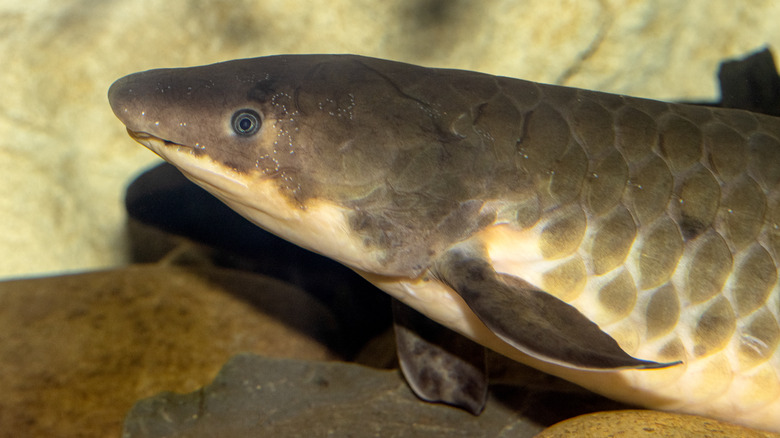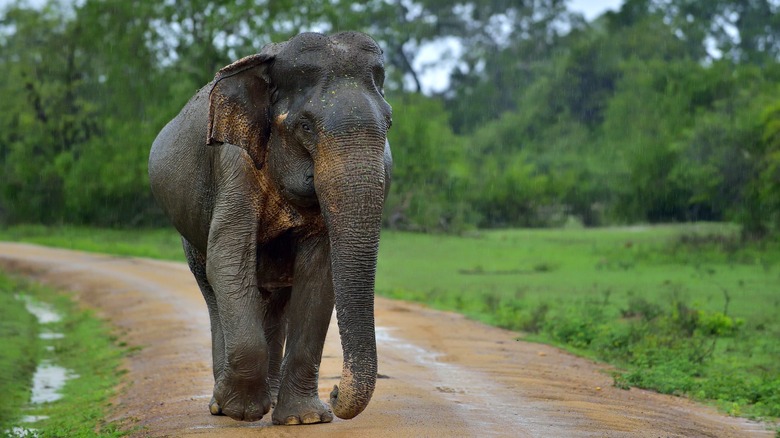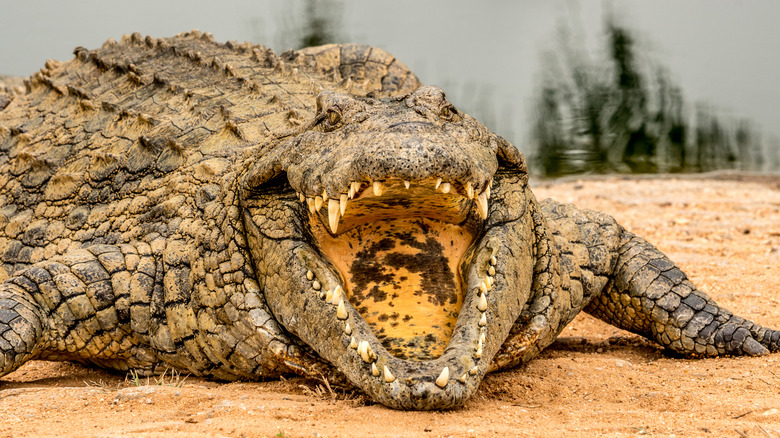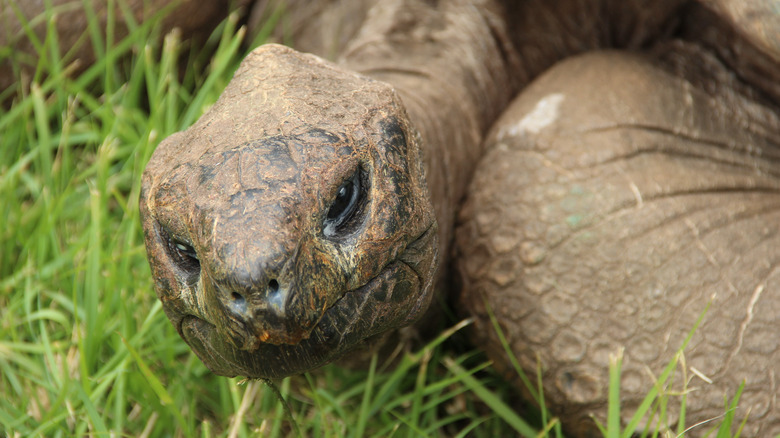These Are The Oldest Captive Animals In The World
The debate over whether animals have a better quality of life living free and wild or in the safe — but limiting — confines of captivity is one that's nearly impossible to settle. We can't well ask the animals we keep as pets, in zoos, aquariums, or other forms of captivity if they would prefer to be in the wild, after all. But one thing that's not up for debate is the fact that many animal species enjoy a much longer lifespan when they live in captivity.
For example, according to Discover Wildlife, in the wild, a gorilla can expect to live some 35 to 40 years, but in captivity, gorillas often live to 50. Wild zebras usually live about 20 years, while in captivity they live about twice that long (via Folly Farm(. Wild wolves live an average of 10 years, while in captivity they often live for 15, per NWF. And on it goes, albeit with exceptions — elephants tend to live longer in the wild, as it happens, according to AWF.
In fact, according to Nature, overall, 84% of mammals live longer kept in captivity than they do in the wild, at least when considering a zoo as the type of captivity thanks to the reduction of threats and the medical intervention opportunities captivity provides. That understood, you'll still be amazed (and even a bit charmed) by the age many of the decidedly aged animals herein discussed have reached.
Midori the koala
In April 2021, a koala named Midori was certified as not only the world's oldest living koala, but also the oldest koala ever known to have lived in captivity, according to Guinness World Records. At 24 years old, the aged animal lives at the Awaji Farm Park England Hill in the Hyogo Prefecture in Japan. On average, koalas only live to a maximum of 15 to 16 years, so Midori's age is indeed remarkable. She would be, in the equivalent of so-called human years, a super-centenarian, meaning more than 110 years old.
Born in the late winter of 1997, the koala will turn a quarter century old not long after the time of this writing. She has lived at the Awaji Farm Park since 2003, having been gifted there from her native Australia, per The China Post. At her home, she receives lots of care from her keepers, including regular brushings, nail clippings, and monthly checks of her weight. She is also given monthly blood tests, and her gut health is monitored closely as well. And as needed, Midori (and the other koalas at the park) are treated to comforting massages. As can be expected of koalas of any age, Midori's days consist of eating, sleeping, and then eating and sleeping more.
Bengali the tiger
In the summer of 2021, Bengali, a female tiger living at the Tiger Creek Animal Sanctuary in Tyler, Texas, was declared the world's oldest known tiger living in captivity by Guinness World Records. Bengali was, at the time of the certification, 25 years and 319 days old, according to UPI. At last check, she had reached 26 and was still doing well for a big cat of such very advanced years.
Typically, a tiger will live for about 15 to 20 years when kept in captivity, and only about 12 years when living in the wild. This is a few years longer than the lifespan expected of the world's other most famous big cat, the lion, which is usually between 10 to 15 years in captivity or eight to 10 years in the wild, according to Wild Life Trip. As is the case in almost all species of mammals, females of the large cat species have lifespans several years longer than those of most males (via Smithsonian Magazine), whether living in captivity or in the wild.
An An the panda
The oldest panda living in captivity is a male named An An who was born in 1986, so he'll be turning 36 in 2022 (hopefully, at any rate), according to CNN Travel. An An lives in Ocean Park in Hong Kong, and he has far outlived most other members of his species. In captivity, age 30 is about the maximum lifespan one can hope for with giant pandas. And in the wild, they seldom live past 20, so it's a safe bet that An An is the oldest living panda on earth.
In more good panda news, in the late summer of 2021, China officially declared the giant panda as no longer endangered, according to National Geographic. The species is still threatened, but compare today to the 1980s — when scarcely more than a thousand wild pandas remained — and you will take some comfort in the improvement of their lot.
Annie the snake
The oldest known captive snake on earth is an anaconda named Annie, according to Times Now News. Annie's advanced age achievement was certified by Guinness World Records in June 2021, when she was established to have reached 37 years old. In the wild, anacondas rarely live much more than 10 years. And while many of these constrictors reach their 20s when raised under human care, few reach their 30s, so the later 30s is even more impressive.
Interestingly, Annie is not all that large of a snake, in the scheme of things: at about 88 pounds and 13 feet in length, it's not like you'd want to see her crawl out from under your bed, but the average female anaconda reaches 15 feet at full length and usually weighs in between 100 and 150 pounds when fully grown, according to Live Science. (And in case you were wondering, the largest anaconda ever recorded was a terrifying 27.6 feet in length and weighed 500 pounds, according to The Natural History Museum of London.) Despite her long life, Annie has never had any babies hatch, so her long-lived genes will not be passed on.
Joe the naked mole rat
Naked mole rats are some of the strangest rodents on planet earth. Their incisors, or front teeth, grow entirely outside of their mouths so they can use them to burrow through the earth, creating tunnels without ingesting soil. They are virtually hairless, as their name suggests. They do not have pain receptors in their skin and don't feel any discomfort from external injuries or inflammation, according to Science. They live in subterranean environments that are pitch black and have low oxygen — the kinds of places that would be lethal to most mammals.
And also, they are very long lived, not being affected by aging the way that most other mammals are. In fact, the oldest known captive naked mole rat is a specimen living in a lab in Capetown, South Africa, who will turn 40 in 2022, according to Wired, living about five times longer than most other rodents. Nicknamed Joe and born in the year 1982, this naked mole rat is the oldest of his species to have ever lived, at least, as far as anyone knows. Scientists are intrigued by how these odd little creatures have become such survivors, especially in the harsh conditions laid out above, and hope that studying them may shed some light on ways to increase human longevity as well.
Fatou the gorilla
The Space Age began on October 4, 1957, when the Soviet Union successfully launched the satellite named Sputnik I into orbit around the earth, according to NASA. Just a few months before that momentous date, a little gorilla was born who, all these years later, is still with us. That would be Fatou, a western lowland gorilla who turned 64 in 2021 and, with luck, will turn 65 a few months after this writing. According to WPTV, Fatou is the oldest gorilla known to be living in captivity, and as gorillas tend to enjoy notably longer lives when living in captivity than in the wild, she is almost assuredly the oldest gorilla alive.
Fatou lives in a zoo in Berlin — her home city of more than six decades — after she was brought to Germany from Africa by way of a stop in the French town of Marseille, according to Independent. The story goes that a sailor, a Frenchman, traded the young gorilla in payment for a bar tab, and after that ignominious exchange, she ended up at the zoo that would be the site of her long, fruitful life. Fatou had only one baby herself, but via her lone offspring, she has become grandmother to two gorillas, great-grandmother to 13 apes, and great-great-grandmother to 16 more, via Dewar Wildlife.
Methuselah the lungfish
The oldest known captive fish is notably older than just about any human being, given the current average human life expectancy of 77.3 years, according to Health Systems Tracker. Methuselah, a lungfish living in the aquarium of the California Academy of Sciences in San Francisco's Golden Gate Park, is at least 90 years old, according to Fox 5 Vegas, and the fish may well be multiple years older than that. The fish, whose gender, like its exact age, is unknown, weighs about 24 pounds, reportedly has a taste for fresh figs, and was in ostensibly good health when last checked.
It's fitting that lungfish have such long lives given their status as such amazing survivors in the animal world. Often referred to as examples of "living fossils," according to the Oregon Zoo, the several extant species of lungfish have survived almost unchanged since prehistoric times. As in 400 million years into prehistory, to be exact: lungfish, which can breathe air and live out of the water for up to a year at a time, have been around since before the time of the dinosaurs, and they have lived through multiple major extinction events that killed off most other animals on the planet.
Vatsala the elephant
According to the Times of India, the average lifespan of an Indian elephant (or of the Asian elephant more generally, for that matter) is between 40 to 65 years, though in some more "extreme" cases, an elephant's lifespan can exceed 75 years. And in one very extreme case, it can even exceed that by 40 years and counting. That case is the life of Vatsala, an elephant known to be over 100 years old, according to The Free Press Journal, and that likely turned 105 in 2021.
Vatsala is the oldest known living elephant and may well be the longest lived pachyderm of all time. Elephants are the second longest lived land mammal after human beings, and this case of an elephant growing to an age few humans reach is indeed remarkable. What's more, after a health scare in the summer of 2021 in which Vatsala, a female living in the Panna Tiger Reserve in the central Indian state of Madhya Pradesh, had ceased eating or consuming enough water, the elephant recovered and in seems to be in fine shape for an animal of her amazingly advanced age.
Henry the Nile crocodile
A Nile crocodile living in captivity in South Africa is the oldest known croc on earth, and at a staggering 121 years of age as of December of 2021, he is one of the oldest known to have ever lived, according to News 24. While a few crocodiles are known to have lived longer, Henry is the oldest around today, and he is in relatively good health for an animal born at the turn of the previous century.
Despite being the oldest Nile crocodile known to be alive, Henry is not the largest. These animals can grow to as much as 18 feet in length, via Largest.org, and weigh up to 2,000 pounds or more. That said, Henry is still a massive animal. He is 16.4 feet long and weighs about 1,100 pounds. He apparently enjoyed a robust birthday meal and is a favorite attraction of the Crocworld Conservation Centre in KwaZulu-Natal, via News 24.
And for the record, the largest species of crocodile on earth is the saltwater crocodile, and according to National Geographic, the largest ever recorded was 20.24 feet long. It was named Lolong and was suspected to have killed at least two humans.
Jonathan the tortoise
There are surely older animals alive right now than Jonathan the tortoise. There are likely bowhead whales and Greenland sharks and giant clams and immortal jellyfish that have a good number of years on him, in fact. There may well be another few captive animals that are older, and if there are, they themselves are likely tortoises. But as we can't be sure there are any older captive creatures, it is to Jonathan the Seychelles giant tortoise that the honor goes: he is the oldest known living animal on the planet, according to News 18.
Jonathan lives on the island of St. Helena, where he is kept (and can be visited) on the grounds of a property called Plantation House. He has lived there for an astonishing 140 years, having been brought to St. Helena in the year 1882. Even more amazing is the fact that Jonathan was already well on in years at the time: he was "fully mature" when he arrived on the island, and his age at the time was estimated to be about 50 years or greater. Which means Jonathan was likely born in or shortly before the year 1832. And yes, that means that with one more decade spent alive, this ancient tortoise will turn 200. At last check, the tortoise was in very good health for a creature closing in on a bicentennial birthday — he has weak eyesight due to cataracts and little to no sense of smell, but he hears well and can still eat plenty.
